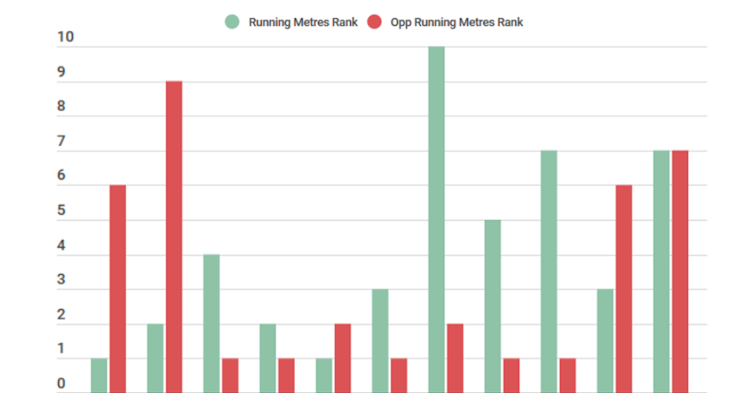NRL | Stats That Matter: Running Metres
Last updated: Apr 6, 2020, 8:00AM | Published: Apr 6, 2020, 6:06AM
''The uneducated only see the bash and barge. They have no idea about the science behind it all.'' - Warren Ryan
Ryan is one of the greatest coaches rugby league has ever seen. It's no surprise to hear him talk about the game as a "science" and look beyond the banging of bodies in the middle of the field. However, that bash and barge through the centre-third is still where games are won and lost.
It's simple, really.
Accumulating more running metres than the opposition tends to give you more opportunities to score, and provided you take those opportunities regularly enough, you end up with more points.
Winning the middle is what allows teams to experiment on the edges. Whether it be a backrower running hard lines, a centre using size and strength to throw away would-be defenders, or a winger contorting his body to get the ball over the line in the corner, those opportunities are all created by what happens in the middle.
Looking over the numbers of the last 11 seasons, winning the running metres battle on both sides of the ball is becoming increasingly important.
WANT MORE NRL CONTENT? Join the free mailing list to get the best content delivered straight to your inbox.
Five of the last six premiership-winning teams have finished inside the top three in running metres per game. Outside of the 2013 Roosters (10th), no team has ranked lower than 7th in running metres and gone on to win the premiership since at least 2009.
Meanwhile, seven of the last nine premiers have allowed the opposition to run for the fewest or second-fewest metres per game. The back-to-back premier Roosters are the first side since 2010 to finish the season holding the trophy while ranking outside the top two in running metres conceded.
The yardage game translates to success.
That much we know.
Where Warren's science comes into it is where those metres are coming on the field, and adjusting your attack to how the defence is reacting.
When we're talking about great tries, the conversation is around the linebreak, the big don't argue or the athletic put-down. In reality, many tries are a result of a play through the middle earlier in the set.
This try from the Roosters in Week 1 of the 2019 finals is a prime example of how a well-planned set is executed to perfection.
They know James Roberts loves to fly out from marker. He's the target even when Jared Waerea-Hargreaves is returning the kickoff on the first tackle.
Brett Morris and Victor Radley take the Roosters up the field through the middle on the 2nd and 3rd tackle, but it's Waerea-Hargreaves' second carry on the 4th that really sets the try-scoring play in motion.
He steams onto the ball and gets his head through the line to produce a fast play-the-ball. With only one player at marker for the Rabbitohs as a result, Cooper Cronk can take a few steps forward before sending Joseph Manu downhill straight at Roberts. The Rabbitohs are on the backfoot and have been scrambling since Waerea-Hargreaves carried the Roosters forward through the middle a tackle earlier.
ALSO READ: Stats That Matter: The Tactical Evolution of NRL
With Roberts flying out from marker, Cronk tips it into Luke Keary.
All of a sudden, the Roosters have created the numbers, and the Rabbitohs can't scramble quick enough to make them up. All it takes is quick and simple hands as ball-players engage defenders, and the Roosters are over to score one of the finest team tries of the season.
The highlights package won't show it, but the dominant run from the Kiwi international is just as important to this try as Cronk's tip to Keary.
Overall, the Roosters led the NRL in running metres per game, metres per run and points per game in 2019. They're one of the best teams we've ever seen, and it shows in the yardage numbers. Only the 2017 Dragons (1,698m), 2015 Roosters (1,699m) and 2015 Cowboys (1,783m) have run for more metres in a single season than the 2019 Roosters since 2009.
| Team | Runs | Running Metres | Metres Per Run |
| Roosters | 174.9 | 1,666.30 | 9.52 |
| Eels | 178.4 | 1,652.30 | 9.26 |
| Storm | 180.3 | 1,647.20 | 9.13 |
| Sea Eagles | 181.8 | 1,614.20 | 8.88 |
| Wests Tigers | 184.7 | 1,604.50 | 8.68 |
| Rabbitohs | 181.4 | 1,592.50 | 8.78 |
| Raiders | 175.7 | 1,590.90 | 9.05 |
| Bulldogs | 184.2 | 1,582.90 | 8.59 |
| Sharks | 178.6 | 1,577.80 | 8.83 |
| Broncos | 170.5 | 1,576.80 | 9.24 |
| Warriors | 175.2 | 1,568.50 | 8.95 |
| Panthers | 181.4 | 1,567.20 | 8.64 |
| Dragons | 176.4 | 1,552.60 | 8.80 |
| Cowboys | 177 | 1,534.20 | 8.66 |
| Knights | 171.1 | 1,506.20 | 8.80 |
| Titans | 175.6 | 1,505.40 | 8.57 |
At the other end of the spectrum, it's difficult to go past the 2016 and 2017 Knights as two of the worst teams in recent memory. Newcastle won six games throughout the two-year span, and while their running metres per game numbers aren't the worst, no team has played with a larger discrepancy in run metres vs opponent run metres over the last 11 years.
Newcastle ran for 341 fewer metres than their opposition in 2016 and 300 fewer in 2017 - 176th and 175th out of 176 collective seasons since 2009.
The fact a team running for more metres than their opposition translates into success won't surprise many. We hear about a team "winning the middle" every week. But if the last 11 seasons tell us anything, ranking anywhere outside the top three in running metres made and running metres conceded makes winning the premiership a lot more difficult.
What about the 2018 Bulldogs who ran for just 20 fewer metres than the premiership-winning Roosters for third-most in the NRL, though?
The 2015 Dragons? They finished third in running metres per game but couldn't score more than 11 points to win in Week 1 of the finals.
Accumulating running metres is all well and good, but it's what you do with them that makes the difference.
Next up in the series, we're continuing to look at the evolution of rugby league by diving into completion rates and how teams that "play some footy" are ending up on top.




